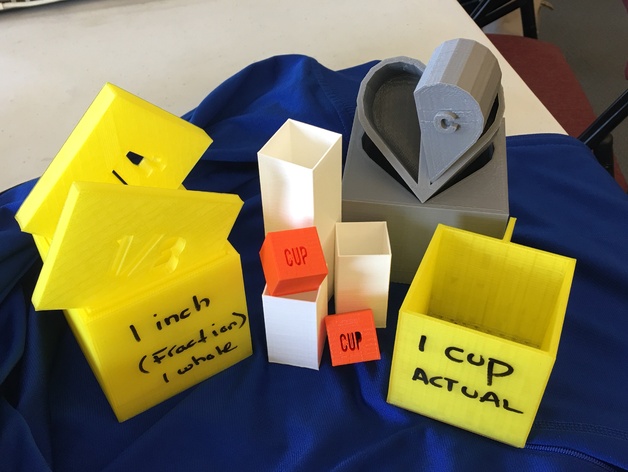
Understanding Properties of Scale
thingiverse
Students will be able to design a representation of parts that make up a whole by creating their own manipulatives to understand concepts of units of measurement. Teacher will guide students from conceptual/scaled model creation to accurate scaled models creation and back. How I Designed This Engineering Troubleshoots When students design their own conceptual or accurate pieces/projects they add do not make exact cut outs because the pieces will not fit without. Models need to be a millimeter smaller to fit within their base. Also consider build height as a factor for time of prints. Standards CCSS Overview and Background The curriculum is broken up into 3 cross curricular units: measurement (science, technology, math), creative design (technology, art, math), and implementation (science, technology, art, social studies, math, english/language arts). Grades 3 - 8 Teacher adjusted difficulty to focus on grade specific standards. Grade 3 Grade 4 Grade 5 Grade 6 Grade 7 Grade 8 Cross Curricular Project Based Learning Collaborate with other teachers for with cross curricular benefits/instruction. Intergraded subjects include (but not limited to): Science Math Art English / Language Arts Technology Standards NY & NJ NY State Common Core Grade 3 - CCSS Math.3.MD.A.2, 3.MD.C.5.A Grade 4 - CCSS Math.4.MD.A.1 Grade 5 - CCSS Math.5.MD.A.1, 5.MD.C.4, 5.MD.A.3 NJ Student Learning Standards Lesson Plan and Activity See attached for complete lesson plans - THING FILE (PDF). Duration is dependent on amount of time teacher meets with class per week. If teacher meets with class 3 times a week for 1 hour, each unit should take about a month to complete. Down the line, consider co-teaching the cross curricular components. Unit Objectives Unit 1 - Students will begin learning by creating conceptual models. The example is used are cups that when put together make a pint, 2 pints make a quart, 4 quarts make a gallon. Students can create this this idea using any 3D shapes by making them fit into each other. We did the same with 1 whole inch into fractions, concept is same. See attached files and photos. After students make a conceptual model, focus will shift to making an model that is accurate. We designed a cup that actually holds a cup of water or sand. Remember to teach students spatial thinking skill strategies. Unit 2 - Sandbox Mode! Once students understand scaled vs actual modeling our curriculum shifts into more creative design. Students will be able to create, design, and build a model of their choosing applying previous skills learned of units of measurements/relationships. For example: office building that holds employees, courthouse that will hold bill of rights, post office that ship and transport packages. Unit 3 - Using relationships learned from Units 1 & 2, students will design, upgrade, and build a scaled version of their school and 2 block radius optimal city grid. Students can choose and create things like a playground, firehouse, movie theatre, home's, needs of community in the surrounding area of their school. Students will learn how to create, estimate, and plot points to determine relationships such as distance and time traveled. Rubric and Assessment Must be teacher created based on grade/goals. Customization can included level of creativity, meeting goals, showing understanding, and so fourth. References Time 60 seconds = 1 minute 60 minutes = 1 hour 24 hours = 1 day 7 days = 1 week 12 months = 1 year 52 weeks = 1 year 100 years = 1 century Length 12 inches = 1 foot 36 inches = 1 yard 3 feet = 1 yard 5,280 feet = 1 mile 1,760 yards = 1 miles Capacity and Weight 2 tablespoons = 1 fluid ounce 8 fluid ounces = 1 cup 2 cups = 1 pint 2 pints = 1 quart 2 quarts = 1/2 gallon 4 quarts = 1 gallon 16 ounces = 1 pound 2,000 pounds = 1 ton 4 cups = 1 quarts 16 cups = 1 gallon 8 pints = 1 gallon
With this file you will be able to print Understanding Properties of Scale with your 3D printer. Click on the button and save the file on your computer to work, edit or customize your design. You can also find more 3D designs for printers on Understanding Properties of Scale.
